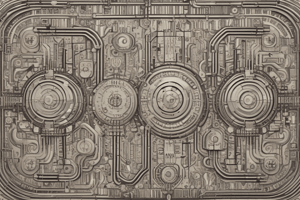Podcast
Questions and Answers
What is the direction of the steady current in the circuit?
What is the direction of the steady current in the circuit?
- From terminal a to terminal b (correct)
- Across the battery terminals
- From terminal b to terminal a
- Through the resistor
What happens to the electric potential energy of the charge dq as it moves from terminal a to terminal b?
What happens to the electric potential energy of the charge dq as it moves from terminal a to terminal b?
- It decreases in magnitude by V (correct)
- It becomes zero
- It increases in magnitude by V
- It remains constant
What is the reason for the increase in the temperature of the resistor lattice?
What is the reason for the increase in the temperature of the resistor lattice?
- Due to the collisions between the electron and the molecules of the resistor (correct)
- Due to the decrease in electric potential energy
- Due to the increase in current with time
- Due to the increase in kinetic energy of positive charges
What is the rate of transfer of energy from electric potential energy to thermal energy?
What is the rate of transfer of energy from electric potential energy to thermal energy?
Why is the transfer of energy from electric potential energy to thermal energy considered dissipated?
Why is the transfer of energy from electric potential energy to thermal energy considered dissipated?
What is the unit of power?
What is the unit of power?
What happens to the kinetic energy of positive charges as they move through the resistor?
What happens to the kinetic energy of positive charges as they move through the resistor?
What is the consequence of the decrease in electric potential energy of the charge dq?
What is the consequence of the decrease in electric potential energy of the charge dq?
What is a characteristic of a resistor?
What is a characteristic of a resistor?
How do we determine if a device obeys Ohm's law?
How do we determine if a device obeys Ohm's law?
What is the definition of a conducting device that obeys Ohm's law?
What is the definition of a conducting device that obeys Ohm's law?
What can be said about the current-voltage relationship in a device that does not obey Ohm's law?
What can be said about the current-voltage relationship in a device that does not obey Ohm's law?
What is the purpose of applying a potential difference of varying magnitude and polarity to a device?
What is the purpose of applying a potential difference of varying magnitude and polarity to a device?
What is true about the resistivity of a conducting material that obeys Ohm's law?
What is true about the resistivity of a conducting material that obeys Ohm's law?
What can be said about the circuit shown in the figure?
What can be said about the circuit shown in the figure?
What is the assumption made about the wires in the circuit?
What is the assumption made about the wires in the circuit?
Flashcards are hidden until you start studying
Study Notes
Ohm's Law
- A resistor is a conductor with a specified resistance that remains constant regardless of the magnitude and direction of the applied potential difference.
- A conducting device obeys Ohm's law when its resistance is independent of the magnitude and polarity of the applied potential difference.
- A conducting material obeys Ohm's law when its resistivity is independent of the magnitude and direction of the applied electric field.
- If the ratio of current to voltage (i/V) is the same for all values of voltage, the device obeys Ohm's law.
Non-Ohmic Devices
- Some conducting devices do not obey Ohm's law, meaning their resistance changes with the applied potential difference.
- Current can exist in these devices only when the polarity of the voltage is positive and the applied potential difference is above a certain threshold (e.g., 1.5 V).
- The relation between current and voltage is not linear and depends on the value of the applied potential difference.
Power in Electric Circuits
- A battery maintains a potential difference across the terminals of a connected device, causing a steady current to flow.
- The amount of charge that moves between the terminals in a given time interval is equal to the current times the time interval.
- The electric potential energy of the charge decreases as it moves from a higher potential to a lower potential, resulting in a transfer of energy to another form.
- In a steady-state condition, the energy transferred is not converted to kinetic energy but rather appears as thermal energy in the resistor.
- The power associated with this energy transfer is the rate of transfer, measured in watts (W).
- The mechanical energy transferred to thermal energy is dissipated and cannot be reversed.
Studying That Suits You
Use AI to generate personalized quizzes and flashcards to suit your learning preferences.




